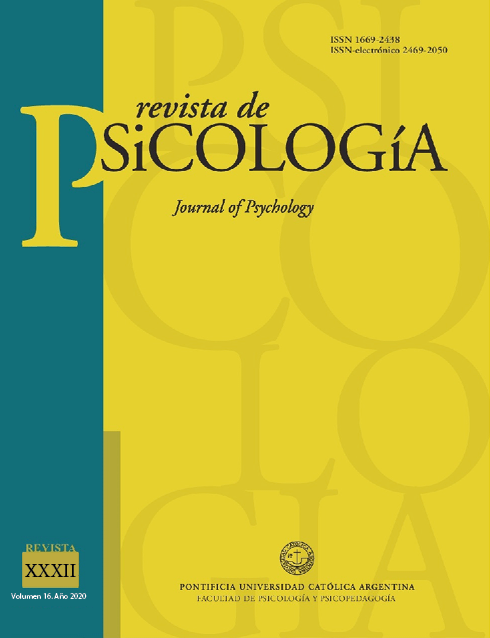Definitions and Levels of Bullying in an Argentinean Adolescent Sample
DOI:
https://doi.org/10.46553/RPSI.16.32.2020.p7-23Keywords:
bullying, definition, adolescents, ArgentineanAbstract
Introduction: bullying is an important risk factor for the mental health of adolescents. Purpose: the present research studied the definitions and level of bullying in adolescents. Sample: a sample constituted of 202 adolescents in Paraná, Argentina. Measures: Smith’s Cartoons Task, Vaillancourt's open question, and Olweus questionnaire to measure bullying. Results: only 8% indicated the imbalance of force, 4%, repetition and 10%, intentionality. In Smith's task, the vast majority could identify bullying vignettes, but they also included situations that were not harassment such as bullying. Conclusion: definitions of what is bullying given by adolescents only partially coincide with the scientific definition of such behavior.Downloads
References
Adornetto, J. (2016). Acoso escolar: definiciones de acoso escolar en adolescentes (Tesis de grado). Universidad Argentina de la empresa, Buenos Aires, Argentina.
Card, N. A., Isaacs, J., & Hodges, E. V. (2007). Correlates of school victimization: Recommendations for prevention and intervention. En J. E. Zins, M. J. Elias, & C. A. Maher (Eds.), Bullying, victimization, and peer harassment: A handbook of prevention and intervention. Nueva York: Haworth Press.
Cheung, F. M., van de Vijver, F. J. R., & Leong, F. T. L. (2011). Toward a New Approach to the Study of Personality in Culture. American Psychologist, 66(7), 593-603 doi: 10.1037/a0022389
Costa, P. T., Jr., & McCrae, R. R. (1992). Revised NEO Personality Inventory (NEO-PI-R) and NEO Five-Factor Inventory (NEO-FFI) professional manual. Odessa, FL: Psychological Assessment Resources.
Craig, W., Pepler, D., & Blais, J. (2007). Responding to bullying what works? School Psychology International, 28(4), 465-477.
Juvonen, J., & Graham, S. (2001). Peer harassment in school. The plight of the vulnerable and victimized. Nueva York: Guilford Press.
Kyriakides, L., Kaloyirou, C., & Lindsay, G. (2006). An analysis of the Revised Olweus Bully/Victim Questionnaire using the Rasch measurement model. British Journal of Educational Psychology, 76(4), 781–801.
Nansel, T., Overpeck, M., Pilla, R., Ruan,. W., Simons-Martin, B., & Scheidt, P. (2001). Bullying behavior among U.S. youth: prevalence and association with psychosocial adjustment. Journal of the American Medical Association, 285(16). 2094-2100.
Olweus, D. (1993). Bullying at school: What we know and what we can do. Cambridge, MA: Blackwell.
Olweus D. (1996). The Revised Olweus Bully/Victim Questionnaire. Bergen, Noruega: HEMIL, Universidad de Bergen.
Olweus, D. (2013). School bullying: Development and some important challenges. Annual Review of Clinical Psychology, 9, 751-780.
Paul, J., & Cillessen, A. (2003). Dynamics of Peer Victimization in Early Adolescence Results from a Four-Year Longitudinal Study. Journal of Applied School Psychology, 19(2), 25-43.
Phillips, V., & Cornell, D. (2012). Identifying victims of bullying: Use of counselor interviews to confirm peer nominations. Professional School Counseling, 15, 123-131.
Resett, S. (2011). Aplicación del cuestionario de agresores/víctimas de Olweus a una muestra de adolescentes argentinos. Revista de Psicología de la UCA, 13(7), 27-44.
Resett, S. (2014). Bullying: víctimas, agresores, víctimas-agresores y correlatos psicológicos. Actas Psiquiátricas y Psicológicas de la América Latina, 60(3), 171-183.
Resett, S. (2017, agosto). Definiciones del bullying en adolescentes. Trabajo presentado en el VIII Congreso Internacional de Educación, Santa Fe, Argentina.
Resett, S. (2018). Análisis psicométrico del Cuestionario de Agresores/Víctimas de Olweus en español. Revista de Psicología de la PUCP, 36(2), 575-602.
Rigby, K., Smith, P., & Pepler, D. (2004). Working to prevent school bullying: Key issues. En P. K. Smith, D. Pepler, & K. Rigby (Eds.), Bullying in schools: How successful can interventions be? (pp. 112) Cambridge: Cambridge University Press.
Runyon, M., Kenny, M., Berry, E., Deblinger, E., & Brown, E. (2006). Etiología y vigilancia en el maltrato infantil. En J. Lutzker (Ed.), Prevención de violencia. Investigación y estrategias de intervención basadas en la evidencia (pp. 21-44). México: Manual Moderno.
Smith, P., Cowie, H., Olafsson, R., & Liefooghe, A. (2002). Definitions of bullying: A comparison of terms used, and age and sex differences, in a 14-country international comparison. Child Development, 73, 1119-1133.
Smith, P., del Barrio, C., & Tokunaga, R. (2012) Definitions of bullying and cyberbullying: How useful are the terms? En S. Bauman, J. Walker, & D. Cross (Eds.), Principles of cyberbullying research. definitions, measures and methodology (pp. 26-40). Nueva York y Londres: Routledge.
Smith, P. K., Kanetsuna, T., & Koo, H (2007). Cross-national comparison of ‘bullying’ and related Terms: Western and Eastern perspectives. Contemporary research on aggression: School violence. World Meeting of the International Society for Research on Aggression,3, 3-9.
Smith, P. K., Kwak, K., Hanif, R., Kanetsuna, T., Mahdavi, J., Lin, S., Olafsson, & Ucanok, Z. (2016). Linguistic issues in studying bullying-related phenomena: Data from a revised cartoon task. En P. K. Smith, K. Kwak, & Y. Toda (Eds.), School Bullying in Different Cultures: Eastern and Western Perspectives (pp- 280-298). Cambridge: Cambridge University Press.
Ucanok, Z., Smith, P. K., & Karasoy, D. (2011). Definitions of bullying: Age and sex differences in a Turkish sample. Asian Journal of Social Psychology, 14, 75–83. doi: 10.1111/j.1467-839X.2010.01334.x
Vaillancourt, T., McDougall, P., Hymel, S., Krygsman, A., Miller, J., Stiver, K., & Davis, C. (2008). Bullying: Are researchers and children/youth talking about the same thing? International Journal of Behavioral Development, 32(6), 486–495.
Wisdom, J., & Creswell, J.W. (2013). Mixed Methods: Integrating Quantitative and Qualitative Data Collection. Rockville, MD: Agency for Healthcare Research and Quality.
Downloads
Published
How to Cite
Issue
Section
License


















